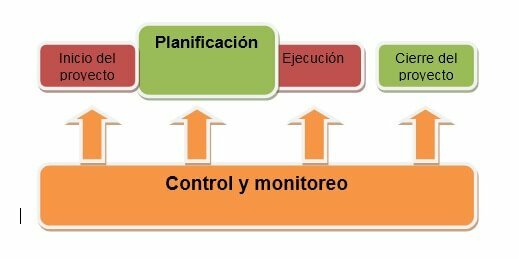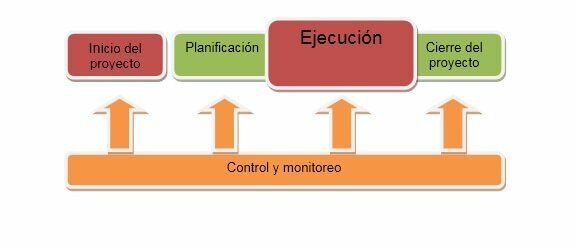In contemporary project management, there are 2 types of philosophies. The first is the so-called Traditional Predictive Model, and the second is called the Agile Model. Both will be described and characterized below:
In this article you will find:
Traditional predictive Project Management Model
The traditional predictive model is a model that is based on solid planning, with control and monitoring of the plan rigorous, in order to be able to identify and verify any type of deviation that may occur during the processes.
Advertisements
Characteristics of the traditional predictive model:
- Staff specialization (dependency): The kind of Traditional predictive project management focuses on teamwork, divided into specializations, in which each team focuses on carrying out a part of the plan based on the specialization as appropriate.
-
Division into clear phases: The traditional predictive Project Management Model refers to work sequentially, that is to say, perform each activity following an order in a formal way in order to achieve the final product as previously stipulated in the same.
- Detailed product requirements: With this characteristic, the traditional predictive Project Management model implies that works through a prior planning where the work to be analyzed, indicated and detailed perform.
- Follow-up of the plan: Traditional predictive Project Management is tracked throughout the process that takes place to carry out the plan. continuous in order to detect any deviation and take the necessary measures to maintain the same as previously stipulated.

Advertisements
- Project start
- Planning
- Execution
- Project closure
- Control and monitoring
As shown in the previous figure, in the Traditional Predictive model, more emphasis is placed on the process of planning, since these is one of the most complex processes in terms of its development. It is here where the most important decisions are made, the tasks and activities to be carried out are defined, times are estimated and resources are designated. Deviations may occur at any time as a result of different factors and, in view of this, the points mentioned above must be re-evaluated.
Agile Project Management Model
The Agile Project Management model is a modern work methodology which was created under the concept of flexibility and adaptability to changes, which seeks a different way of developing projects in which the focus of attention is the final score.
Advertisements
Although Agile Project Management is proposed as a different way from the traditional one, it does not leave aside the management of the processes, which under this methodology must be adapted to the reality of the company and not to the reverse. The same happens in the field of documentation, regulations, procedures, etc. which are not left aside by this methodology but rather are in another position in terms of the focus of orientation and priority table, which as mentioned before is directed to the final product and satisfaction of the client.
This method values client collaboration more than contractual negotiation, becoming a part of the work team.
Advertisements
The fundamental axis of this methodology is the response to change, and its main values are anticipation and adaptation, in change traditional predictive management focuses more on planning and control in order to avoid deviations on the plan.
Characteristics of the agile Project Management Model:
Advertisements
- Multidisciplinary team: This methodology prioritizes the formation of work teams which all work together and not in which Divide into small specialized groups, each in charge of carrying out their own area of the plan.
- Overlapping: The way this methodology works is to work without knowing what the final result of each activity, that is, it is working without having previously detailed requirements when starting the stages. This implies that the team that develops the project carries out all the activities from the beginning simultaneously and the changes and adjustments are made at the moment.
-
Product vision: With this characteristic, this Project Management model raises the importance of focusing on the final result, that is, the product.
- Adaptation to changes: This management model suggests that priority should be given to giving a rapid response to change rather than to monitoring the plan.

The previous figure shows that the Agile Management model focuses more on execution, that is, it focuses on the realization of the final product, so that it can be applied immediately the necessary corrections in the event that it is not being carried out optimally, in addition, as mentioned above, it incorporates the customer's opinion at all times.
Characteristics of the Agile Project Management Model
- Project start
When starting the project, the agile Project Management is in charge of forming a team that carries out the project, as well as the Management of Traditional predictive projects, the appointment of a project manager or director and a qualified team is essential for the achievement of the objectives.
However, when talking about the necessary documentation to develop in order to carry out the project, for Agile Project Management it does not have the same value and importance, because this is not based on knowing in advance and in detail the characteristics of the final product you want deliver but rather focuses on the value of the result where Innovation and flexibility are two fundamental characteristics for delivering value.
This management model also considers environmental factors, such as current legislation, legal aspects, to highlight a few.
- Planning
Planning is not the basis of this Project Management model, since as previously announced it is not based on knowing in advance the result or product However, it refers to a Phase called "Concept", which implies knowing what is wanted as the final result and what will be the scope that the draft. For this, the knowledge of all this information by the work team that will be in charge is essential.
Directly related to the "Concept" phase is another phase called "Speculation" that for traditional Project Management would be concentrated within the planning this because in these phases the limitations of the project are determined referring to costs and an approximate idea of what the product will be final.
However, in the same way as the Predictive and traditional management model, it refers to the development of plans:
- Delivery plan: Plan that refers to the development time of the project.
- Risk Management Plan
- Execution
As previously emphasized, execution is one of the phases where more emphasis is placed on this type of model of management, this is where he focuses his greatest concentration and teamwork, and where the product will be achieved final.
Flexibility is an important point in this Management model, since it is not only based on the result of the final product, but on the flexibility and adaptability that it must have due to the constant changes and requirements of the environment and customer needs, for this model it is not a problem to have to adapt quickly and not follow what is planned in a beginning, because this is the purpose for which it was created, to provide a fast solution, with fast delivery of results and that is capable of reacting to an unstable environment and fast functioning.
- Project closure
For this management model, the closure of the project does not mean the end of the project, because this model is based in innovation and flexibility, which presumes that the final product will be improved frequently so as not to be obsolete. It is important to note that this model does not neglect the product vision that bases its research and construction on this throughout the development of the project.
- Control and monitoring
Control and monitoring is carried out by a phase called "Review" where it is periodically reviewed in contrast to the objectives set at the beginning.


